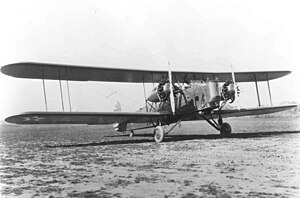Keystone B-3
| B-3A | |
|---|---|
 Keystone B-3A (S/N 30-281), the first B-3A built. | |
| General information | |
| Type | Bomber |
| Manufacturer | Keystone Aircraft |
| Status | Retired |
| Primary user | United States Army Air Corps |
| Number built | 63 B-3A/B-5 |
| History | |
| Variants | Keystone B-4, B-5 & B-6 |
The Keystone B-3A was a bomber aircraft developed for the United States Army Air Corps by Keystone Aircraft in the late 1920s.
Design and development
The B-3 was originally ordered as the LB-10A (a single-tail modification of the Keystone LB-6), but the Army dropped the LB- 'light bomber' designation in 1930.
Although the performance of the B-3A was hardly better than that of the bombers flown at the end of World War I, it had come a long way in terms of flight safety.
Operational history
The B-3A was a member of the last family of biplanes operated by the US Army; it remained in service until 1940. A few years after it was first produced, the introduction of all-metal monoplanes rendered it almost completely obsolete.
Variants
- LB-10
- The last of the 17 LB-6s ordered (S/N 29-27) was converted with a re-designed single fin and rudder and two 525 hp Wright R-1750E engines. Delivered to Wright Field on 7 July 1929, it was wrecked on 12 November 1929.
- LB-10A
- This version used Pratt and Whitney R-1690-3 Hornet engines and was slightly smaller, in both wingspan and length. A total of 63 were ordered (S/N 30-281/343). All were re-designated as the B-3A before any deliveries were made, with the final 27 built as B-5A with Wright engines.
- B-3A
- Ordered as LB-10A, 36 delivered as B-3A (S/N 30-281/316). The first aircraft was delivered in October 1930.
- B-5A
- Ordered as B-3A, re-engined with Wright R-1750-3 Cyclone engines, 27 built (S/N 30-317/343).
Operators
- United States Army Air Corps
- 2d Bombardment Group, Langley Field, Virginia
- 20th Bomb Squadron – operated B-3A and B-5A 1931–1932
- 49th Bomb Squadron – operated B-3A and B-5A 1931–1932
- 96th Bomb Squadron – operated B-3A and B-5A 1931–1932
- 4th Composite Group, Nichols Field, Luzon, Philippines
- 28th Bomb Squadron – operated B-3A 1932–1937
- 2nd Observation Squadron- operated B-3A 1938–1940[1]
- 5th Composite Group, Luke Field, Territory of Hawaii
- 23d Bomb Squadron – operated B-5A 1932–1937
- 72d Bomb Squadron – operated B-5A 1932–1936
- 6th Composite Group, France Field, Panama Canal Zone
- 25th Bomb Squadron – operated B-3A 1932–1936
- 7th Bombardment Group, March Field, California
- 9th Bomb Squadron – operated B-3A 1931–1934
- 11th Bomb Squadron – operated B-3A 1931–1934
- 31st Bomb Squadron – operated B-3A 1931–1934
- 19th Bombardment Group, Rockwell Field, California
- 30th Bomb Squadron – operated B-3A 1932–1936
- 32d Bomb Squadron – operated B-3A 1932–1935
- Air Corps Advanced Flying School, Kelly Field, Texas
- 42d Bomb Squadron – operated B-3A and B-5A 1935–1936
- 2d Bombardment Group, Langley Field, Virginia
- Philippine Army Air Corps
- 10th Bombardment Squadron
Specifications (B-3A)
General characteristics
- Crew: 5
- Length: 48 ft 10 in (14.9 m)
- Wingspan: 74 ft 8 in (22.8 m)
- Height: 15 ft 9 in (4.8 m)
- Wing area: 1,145 sq ft (106.4 m2)
- Empty weight: 7,705 lb (3,495 kg)
- Gross weight: 12,952 lb (5,875 kg)
- Powerplant: 2 × Pratt & Whitney R-1690-3 radial engines, 525 hp (392 kW) each
Performance
- Maximum speed: 114 mph (183 km/h, 98 kn)
- Cruise speed: 98 mph (158 km/h, 85 kn)
- Range: 860 mi (1,400 km, 760 nmi)
- Service ceiling: 12,700 ft (3,870 m)
- Rate of climb: 530 ft/min (2.7 m/s)
- Wing loading: 11.31 lb/sq ft (55.42 kg/m2)
- Power/mass: 0.0811 hp/lb (133 W/kg)
Armament
- Guns: 3 × .30 in (7.62 mm) machine guns
- Bombs: 2,500 lb (1,100 kg); 4,000 lb (1,800 kg) on short runs
See also
Related development
Related lists
References
- Notes
- ^ "Fact Sheet – Keystone B-3A." National Museum of the United States Air Force. Retrieved: 14 July 2017.
- Bibliography
- Andrade, John. U.S. Military Aircraft Designations and Serials since 1909. Leicester, UK: Midland Counties Publications, 1979, pp. 43, 135. ISBN 0-904597-22-9.
- The Illustrated Encyclopedia of Aircraft (Part Work 1982–1985). London: Orbis Publishing, 1985, p. 2255.
- Maurer, Maurer. Combat Squadrons of the Air Force, World War II. Maxwell AFB, Alabama: Air Force Historical Studies Office, 1982. ISBN 0-89201-097-5.
